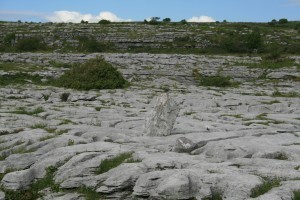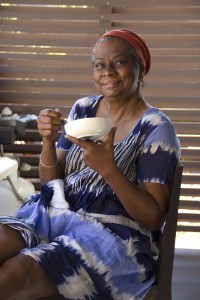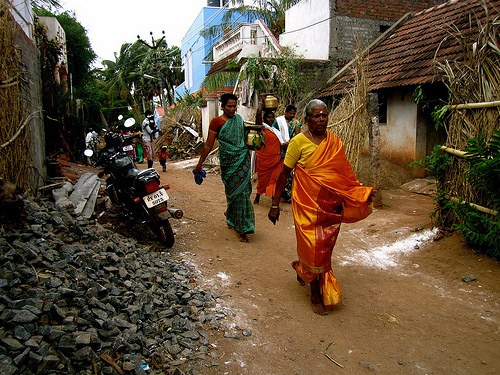Lisa Niver's Blog: We Said Go Travel, page 459
October 25, 2013
Dubrovnik: An Unofficial World Wonder
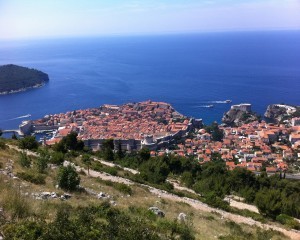 Dubrovnik: An Unofficial World Wonder
Dubrovnik: An Unofficial World Wonder
by Armand Diab
I’ve only been to Dubrovnik twice in my life: as a child, when I lived in Bosnia and visited it during a field trip with my 2nd grade class, and as an old adult, only 2 years ago. The beauty and history of the Old City fascinates me to this day. Not only is it a great – and very affordable – place to vacation during the summer, but it is also a historical landmark, one that even Napoleon conquered some few hundred years ago. And that’s just one of the ways it inspires awe in me.
Located on the Dalmatian coast in the Adriatic sea, Dubrovnik is Croatia’s most famous tourist attraction. Every year, hundreds of thousands of people from all over the world travel to it, exploring its endless wonders: its crystal clear ocean water, its fabulous beaches, and the prestigious Old City, which deserves a label as one of man-made Wonders of the World. Upon my last visit to Dubrovnik in the summer of 2011, I was impressed by how much it had changed from the way I remembered it as a child: it seemed to be an international city, with all sorts of languages spoken at every corner, and it appeared to be bigger, even though it probably wasn’t. The wide diversity of people I saw during my week of stay there was beyond belief, and it made my holiday that much more special and memorable. It felt as if I was travelling through the entire Europe, and not just one city in Croatia.
Because Dubrovnik attracts so many people of different nationalities, it will naturally have a wide variety of restaurants. If you want typical Croatian food, you will find it on every corner, and naturally so. Or perhaps you fancy yourself a pizza? Well, in Dubrovnik I’ve tasted some of the best pizzas in my life. They follow the recipe, ingredients and crust type of the original pizza from their neighbors across the Adriatic Sea: the Italians. With that kind of inspiration, you know you can’t go wrong, especially when the menu offers at least 30 different types of pizzas. Everyone will be able to find their pie of choice.
The Dubrovnik sea is a special kind of sea. It is surprisingly crystal clear, pure and on a cloudless sunny day – which in Dubrovnik is most of the time – it reflects the sky so perfectly that even the most gifted painter would be envious of its appearance. The water’s temperature is always pleasant and warm, and the sights and sounds it produces as the waves splash onto the shore are a perfect lullaby for the traveler looking to nap on the beach while tanning.
There are also plenty of cafes and bars, and often right on the water. I sat in a bar outside of Dubrovnik’s Old City, and as I drank my beer while watching the beautiful islands in the distance, I noticed that many of the patrons were swimming in the water, just 20 or 30 feet away from where I was sitting. Envious of the joy they were having, I put my beer down, took my shirt off, and joined them. Eventually I found out they were also from the United States (Atlanta). When we got out of the water, we had a beer together, and talked about the elusive beauty of this great destination. Why is it that more Americans don’t talk about Dubrovnik as one of the major cities to visit when travelling in Europe? We vowed we’d spread the good word as soon as we got back, because no place this unforgettable should go unnoticed by so many.
Dubrovnik was, is and always will be a place that inspires awe in me. It is a city that I could – if my schedule and finances would allow me – visit at least once a year, during its busy tourist season. June, July and August are excellent months to go there, for not only is the weather perfect, but there are also numerous summer festivals, events and other festivities to be a part of. Dubrovnik may not officially be a World Wonder, but for me it always will be just that, and much more.
About the Author: Armand Diab is a 35 year old former Corporate Video production freelancer who graduated from Columbia College Chicago in 2002 with a Bachelor’s Degree in Film & Video Production. He is currently teaching English in Shenzhen, China. He will be there until the end of June 2014.
The post Dubrovnik: An Unofficial World Wonder appeared first on We Said Go Travel.
October 24, 2013
Japan: The Magic of Shirakawa Gō
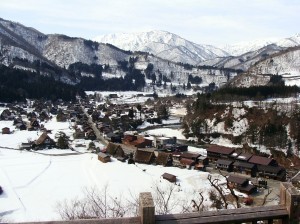 Japan: The Magic of Shirakawa Gō
Japan: The Magic of Shirakawa GōI once wrote a poem about the Shirakawa Gō (traditional) Village, that started like this; ‘In far away, almost forgotten land, among mountains and valleys, as if someone tried to hide it, from the world like a precious gem, there is a place, that tells us the story, of once upon a time – nostalgic, old Japan.’ Shirakawa Gō is a perfect place in which you lose your connection with the outside world; reunite with the nature, while breathing the fresh air of the mountains and walking among the small houses on both sides of you, built in a traditional way, giving you the opportunity to explore the once upon a time, Japan.
Shirakawa Gō is located in the northwestern part of Gifu Prefecture, Japan. It is known for its Gassho-zukuri houses, made of wooden beams combined to an A form roof that resembles two hands of a praying man. In case you are interested to stay in the village for the night, it is better to make the reservations in advance and chose to stay in a traditional house. I had the opportunity to visit the village during the early spring time, when most of the village’s area was still covered with snow, and the temperatures were below zero Celsius. If you visit the village during the winter time, you are about to experience a winter fairytale, seeing the traditional houses being covered with snow, sparkling-a truly unforgettable magic. The traditional houses contain proper heating and bathes, and the rooms contain futons (traditional Japanese bedding) instead of regular beds. Two meals are being served during the day; breakfast and dinner; the dishes include vegetables, fresh water fish, miso and other variety of traditional healthy Japanese food. Staying in a traditional house, you have the opportunity to meet other guests and hear their stories about what made them to visit the village while sharing your impressions.
During the day, if you are lucky enough, you can observe the ‘changing the roof’ process of the traditional house, which very well resembles the ‘knitting a quilt’ process. This work makes the village’s people join hands in one mission, and such tradition has been passed down from generation to generation. There are many souvenir stores that sell the village’s goods, mostly being located along the main road; it is a great opportunity to make sure that this trip will be remembered forever. Along the souvenir houses, there are several house-museums that tell us the stories of the village which can be visited with additional payment. During a break time, a warm meal together with a hot tea, especially handmade ‘Matcha tea’ (powder green tea) is very much recommended. If the weather is too cold for you, it is better to visit the public bath located within the village, and continue your trip with a warmer feeling.
The Shirakawa Gō traditional village is located next to the Shirakawa village itself, where people’s lifestyle is modern. While walking the streets of the modern village, I’ve been amazed of how interesting it is to keep the modern and the traditional life so close to each other, like a small time machine in the mountains. On the way from the traditional village to the modern one, there is an exquisite coffee place, with various sorts of coffee from all around the world; I had a great chance to chat with the owner who told me about the village’s stories.
From the Shirakawa Gō viewpoint, while overlooking at the entire village, you might think that someone accidentally spread the houses like brown beads, from a precious necklace on a white sacred veil. Please try to imagine that the person who did it is yourself, and you are the one that writes the magical story of the traditional village, of once upon a time – nostalgic, old Japan.
About the Author: Victoria Kupchin. Born in Moscow, USSR in 1982, at the age of 9 immigrated to Israel. B.A. in Comparative Literature and East Asian Studies, from Tel-Aviv University (graduated in 2005). M.A. in East Asian studies (Japanese) from Hebrew University.
The post Japan: The Magic of Shirakawa Gō appeared first on We Said Go Travel.
Albayrak: Red Flags all Over Turkey!

The Turkish Flag
Albayrak: The Red Flags all Over Turkey!
I will start by saying that I’ve never seen so much Red in my life, as I saw in Turkey in a few weeks, when I visited a couple of years ago. Whether on boats sailing past the Bosporus, on the façade of buildings, over balconies of private residences, or in cafes, gardens, small businesses, public squares, parks, or even into the sky if you cared to look looked overhead, ‘Red’ is all over.

Into the Skies of Istiklal
What is Red?
A creamy white crescent moon and a star facing each other, against a lush backdrop of red. This for you is Turkey’s national flag also called “Albayrak”( the red flag) or “Ayyıldız”(the moon-star). To be honest, I did not know this until I stepped out of the aircraft into Istanbul’s Ataturk Airport, and was accosted by its presence everywhere. Alighting from the Hawas airport shuttle bus at Taksim Square, I swear I could have counted close to 200 flags in the span of an hour. Certainly an impressive figure because back home in India, our flag mostly makes its appearance on Republic Day and Independence Day. And I’ve never seen our tri-colour hung down the entire length of a colossal building.

Father of Modern Turkey – Ataturk alongside the flag
Turkish friends told me that on National Days namely 29th October (Republic Day of Turkey), the country is drenched in pools of crimson. Even individuals and commercial establishments readily sport their country flag.
Turks who have never travelled out of their country are habituated to its ubiquity however those who have started to travel abroad return home to look at their public spaces in an increasingly new light.
It’s true that countries such as Thailand also match up in this respect. Bhutan comes close with its banners of the King and Queen all over the hilly landscapes. However the Turkish flag (Albayrak)hits home in a big way with tourists because of its primarily red hues with splashes of white. This flag is far from being forgettable!

Wet Streets of Kadikoy (Asian Part of Istanbul)
Walking through Istanbul’s historic pedestrian street, Istiklal Caddesi, I look up at the skies and make a half-hearted attempt at counting. Am amused group of Turks are more than happy to share their opinions, telling me that though it appears overly-nationalistic and militaristic, the flag is sacred to most Muslim Turks because of the crescent moon (hilal) embellished upon it. Mustafa Kemal Ataturk, the Father of Modern Turkey himself did not alter the flag much despite efforts to depart from the Ottoman regime.
Another guy I met in the Island of Assos (Behramkale) surprised me by saying that the flag is hoisted when a Turkish couple gets married. Also it could be used to cover the coffins of martyrs, soldiers, presidents, teachers, veterans, world and Olympic champion athletes, etc. His list was definitely longer that what I remember today. Meanwhile in the coastal city of Izmir, sellers walk around the Old City centre with meter long flags.

Flag Seller in Izmir
But Everyone is Not as Gung-Ho
I remember the first time I stepped into my friends’ apartment, I was sure it would be adorned by flags but it wasn’t. These guys were all young Turks who didn’t see the point of their flag being thrust into the public eye, as if to remind people lest they someday forget. Clearly every Turk did not feel the same allegiance though they were fiercely proud of their Turkish roots.
Ezra, a passionate young Turk had a radically different opinion exclaiming, ‘Turkish flag means being proud of being a Turk. There is a quotation “Ne mutlu Turkum Diyene!” means “How happy is the one who says “I am a Turk”. This sentence is the ending sentence of the oath that every kid living in this country have to say loud before starting their classes. Every day I had to shout this sentence till my age of 17. Such arrogance…
Why am I so against being proud about being Turk? Because Turk means oppression of other nations living in Turkey. They are not Turk, but Kurd, Laz, Cherkes Aserian, Armenian, Greek or any other ethnic culture which have been living on this geography for ages. And now, they have to call themselves Turk, they have to speak Turkish, they have to be Muslim, above all they are not welcome any more. Otherwise, they have to live with heavy discrimination. Calling someone Armenian is a bad word in Turkey. Can you believe that? State puts flag shapes even on the mountains of Kurdish region. This is insane.’
In sharp contrast, another Turkish woman Sule mulls, ‘Our flag, my flag is holy for us. We never let a flag fall into place -ground. We represent it everywhere because it represents us,our honourable history and ancestors. If the subject is to talk about the flag, words fail here. Flag is our independence, our history and honour.’

Art Gallery in Kadikoy
I can conclude saying this much, and only this much:
Albayrak is one of the most aesthetic and deeply engaging flags I ‘ve seen this far. To me, it evokes memories of a sojourn where I lost count of the times chai (tea) was offered on the house at bus stops, tourism offices, fruit markets, even outside mosques and cafes.
Until then, Görüşürüz! (pronounced go-roo-shoo-rooz)
See you later! (in Turkish)

Headed towards Galata Bridge
The post Albayrak: Red Flags all Over Turkey! appeared first on We Said Go Travel.
Christmas in the Dales
 Life can get pretty hectic in the run up to Christmas, so why not leave the hustle and bustle behind and escape to the great outdoors. There is no better place to wrap up against the wintry weather and enjoy some fresh air in the miles and miles of rolling countryside in the Yorkshire Dales.
Life can get pretty hectic in the run up to Christmas, so why not leave the hustle and bustle behind and escape to the great outdoors. There is no better place to wrap up against the wintry weather and enjoy some fresh air in the miles and miles of rolling countryside in the Yorkshire Dales.
There are hundreds of walking routes throughout the villages and open countryside, ensuring you can have a proper break from the big smoke of the city. The most well known in the area is, of course the Three Peaks – a trek up three of the highest summits in the area.
Together Pen-y-ghent, Whernside and Ingleborough makes up a 24.5 mile route starting in Horton-in-Ribblesdale, but if you are looking for something a little less strenuous or something that all the family can join in with then the Ingleton Falls Waterfall Trail is a winter wonderland of a walk.
It is just over four miles and the colours at this time of year will be spectacular with a variety of rare plants, birds and trees to be spotted along the route. Following a map you will take in Hollybush Spout – a river running through the valley – before coming to five other waterfalls – the main one being Thornton Force which pours 14 metres over a limestone cliff, formed 330 million years ago.
After taking in Beezley Falls, Rival Falls and Baxengyhll Gorge – where there is a viewing bridge but not for the faint hearted you will pass Snow Falls before coming back into the picturesque Ingleton Village. If, however, you are missing a bit of retail therapy then visit one of the many festive markets being held across the Dales in the run up to Christmas.
In Skipton there is a Yuletide Festival and Christmas market from 8 to 15 December with over 150 stalls with gifts, local produce and traditional hot roasted chestnuts and mulled wine. But perhaps, the most well known event to get you into the festive spirit is the Grassington Dickensian Christmas Festival taking place over three Saturdays – 30 November, 7 and 14 December.
Travel back in time for street entertainment, buskers, shoe-shine boys, chestnut sellers, Santa’s Grotto and an outdoor market. Make the most of your escape from reality with a stay in one of Ingrid Flute’s charming and cosy holiday cottages to complete that perfect weekend getaway.
About the Author: Emma Dale: Currently a journalist for the Whitby gazetter, my passions are for all things Yorkshire. I feel privilaged to be living and working in one of the most beautiful areas in England. From it’s stunning rolling hills to its quaint seaside towns such as Whitby, Yorkshire has something for everyone.
About the Author:
The post Christmas in the Dales appeared first on We Said Go Travel.
October 23, 2013
France: Steps of Le Panthéon
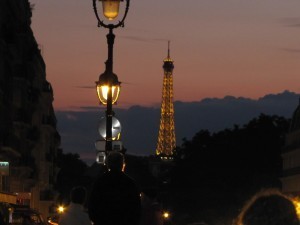 Life is astounding. It works in many mysterious ways; it can surprise you, it can challenge you, it can beat you down; but above all, it can amaze you. I have had people amaze me, ideas and theories amaze me, and best of all, I have had places amaze me. Finding beauty in the most simple or the most dynamic of things is never something that evades me. I can be awed by a basic garden, booming with color and full of life; at the same time, I can be awed by a complex system like Calculus, full of byzantine equations and definitions.
Life is astounding. It works in many mysterious ways; it can surprise you, it can challenge you, it can beat you down; but above all, it can amaze you. I have had people amaze me, ideas and theories amaze me, and best of all, I have had places amaze me. Finding beauty in the most simple or the most dynamic of things is never something that evades me. I can be awed by a basic garden, booming with color and full of life; at the same time, I can be awed by a complex system like Calculus, full of byzantine equations and definitions.
Nothing is more awe-inspiring, however, than the Eiffel Tower lit up at night on Bastille Day. While everyone raves about how beautiful the Eiffel Tower is in general, the structure’s simplistic design adds to the loveliness. As an aficionada of architecture, seeing the Eiffel Tower in person was enough to make me squirm, but seeing it for the first time twinkling against the pitch-black sky just added to the greatness of the experience. What made this moment even more special was spending it with someone I love, my boyfriend. They say Paris is the city of love, and I was lucky enough to get to spend a week in Paris with the love of my life.
The fact that you can see the Eiffel Tower from just about anywhere in Paris is a no-brainer, but I cannot imagine watching the fireworks and the illuminated Eiffel Tower light up the night sky from anywhere else in the city. My boyfriend and I walked about thirty minutes through construction and traffic and somehow came across Le Panthéon National, a French mausoleum situated in the 5th arrondissement on Montagne Sainte- Geneviève, a hill that positioned Le Panthéon to be in the perfect location that overlooked much of the city and had an astounding view of the Eiffel Tower, provided you were on the front side.
From sitting on the steps of Le Panthéon, we had a perfect view of the Eiffel Tower, not too far in the distance. The location was great because as we waited for the fireworks to begin, we could walk down the main road, Rue Soufflot, leading up to Le Panthéon National. On that road were various antique shops, modern boutiques, cafés and creperies, and libraries; but at the very end of Rue Soufflot was Amorino, a small Italian gelato shop that serves the best gelato on the planet! My boyfriend and I visited some of these shops for a few minutes and then took our time in Amorino, picking out the perfect flavor of ice cream that we would savor as we watched the firework show.
Once we returned to the steps of Le Panthéon, at least a hundred more people had shown up and were sitting on and in front of the steps. We ultimately had to find a different place on the steps to sit, but that did not hinder the experience; for when the fireworks started, we could still see them perfectly. Being in Paris for its national holiday is one thing, but I am very grateful for having the opportunity to watch the fireworks over the Eiffel Tower with someone that was just as important to me as the experience I had.
About the Author: Bailey Hill: I am from a small town in Illinois and am studying Astrophysics at the University of Illinois in Champaign-Urbana. I spent a month in France in the summer of 2012 and that totally changed my life! I love writing and traveling, and twitter.
The post France: Steps of Le Panthéon appeared first on We Said Go Travel.
Thimphu, Bhutan: National Memorial Chorten
Bhutan is a Buddhist country where religion is taken seriously, one sees monasteries, temples, chortens, and prayer flags, across the country. The most ubiquitous of these are the chortens. Stone or earthen square structures, with proportions about twice as tall as wide, a sloped stone roof, the shape much like a cupola, as small as a dog house or large as a house. The structure is solid, with a relic or valuable object secreted somewhere in the base. Always white, with a rust red band running horizontally near the top. There are variations, subtle or extreme, in the design, but the overall look is such that new visitors are soon able to recognize a chorten notwithstanding the varying styles.
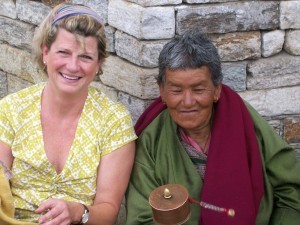
Marianne and Bhutanese woman at National Memorial Chorten
Biggest of all is the National Memorial Chorten in Bhutan’s small capital, Thimphu. Not a strict adherent to the traditional style, it’s 3 stories tall and not solid, the base houses a temple that can be entered and is home to altars and statues of the Buddha and other deities. This chorten is about 15 years old, centuries younger than most. It lacks the beauty and grace of many, and has a slightly gaudy look to it. My aesthetic critique aside, it is very heavily visited by Bhutanese. Elderly people spend much of the day there, circumnambulating in the proscribed clockwise direction, swinging prayer beads and holding prayer wheels they keep spinning with a motion of the wrist, each spin sending more prayers aloft. Others pay shorter visits to give thanks or pray for assistance or guidance. Talkative students tell us their visit is due to upcoming exams. Tourists visit as it’s a significant site, and while one may not fathom Buddhism, its impact on locals is touching and profound, and I am always compelled to offer my own silent prayers.
This visit I’m carrying photographs taken by Marianne, who accompanied me to Bhutan some months ago. At the chorten her group met a number of elderly women. We approached these women, who looked like transplants from the 17th century and asked for permission to photograph them. Elderly people typically dress in the traditional manner, women in ankle length skirts stitched from locally woven multicolored cloth. A tunic like top is fastened to the kira, with silver dollar size ornate brass or copper buttons and pins, which hold it in place. The resulting look is colorful yet restrained. These women were born long before the introduction of English as medium of education, so our requests were non-verbal, yet easily understood and granted. They enjoyed seeing the images of themselves, and indicated they wanted to be photographed with us. Dorji translated when our sign language failed, and we learned they come every day to pray. Devout as they may be, it was pretty clear there’s a good social component to their day. Marianne wanted to get them copies of the pictures, so Dorji suggested she give them to me to distribute upon my return.
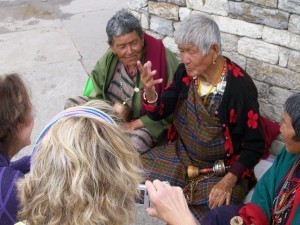
Marianne photographs her new friends.
I arrive with a handful of her photos. There are thousands of people at the chorten. Dorji hands the pictures to our driver Pema, and in Dzongkha tells him to locate these women. From Pema’s response, it’s pretty obvious he’s said something like, “you’ve got to be kidding.” We sightsee for 10 minutes, and find Pema still searching for the needle(s) in the proverbial haystack. The women are not where they sat 4 months ago, and I’m ready to conclude that we gave it our best and let it go. Moments later Dorji spies one of the women. We look from picture to person and all of us agree that it is she. He hands me the photo, and I approach her. For a split second she seems to register puzzlement. Then she sees her picture and a grin erupts over her face, followed by a torrent of words. I show her the other pictures, and within seconds we have a crowd of elderly people around us. The others in the pictures are present, and all of them are smiling, gesticulating and shouting (or what passes for shouting in Bhutan, where voices are never raised). While there’s a language barrier, we cannot miss their excitement. Dorji is fielding questions from the crowd, he says they are all asking for their photo, “where’s my picture, so many tourists take my picture, I want my picture.” He’s left explaining that one person took these photos and we have only these to distribute. As many do not hear he needs to repeat this numerous times. While disappointment might be expected, they all seem thrilled with the photos we have and the recipients pass them around for everyone else to see, and again language not needed to observe how much excitement and happiness the crowd shares.
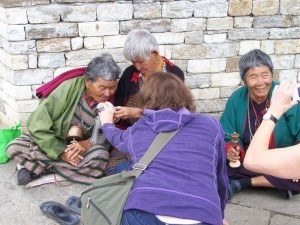
Elderly Bhutanese Women at National Memorial Chorten, Thimphu
While we might have made their day (very few Bhutanese seem to have actual photos of themselves), they’ve made a good part of our day, and it could only have been better had Marianne directly observed the delight her gesture provoked.
The post Thimphu, Bhutan: National Memorial Chorten appeared first on We Said Go Travel.
October 22, 2013
California: My trip to the city of Angels
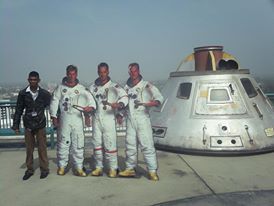 Going to Los Angeles California was a dream come true for me. It is something that I will never forget and cherish for the rest of my life.
Going to Los Angeles California was a dream come true for me. It is something that I will never forget and cherish for the rest of my life.
I was busy preparing for a Math test, when my Dad phoned to inform me that we would be taking a trip to the City of Angels. I became hysterical and was in a state of deep excitement for the two weeks prior to the actual trip.
I am a fan of American culture, and visiting USA, was something that I dreamed about, yet thought would not have happened. Prior to visiting LA, my knowledge of the city did not extend very far. All that I knew about it was that my childhood icon, footballer David Bechkam had found himself a nice quiet retirement village at soccer club, LA Galaxy.
So after boasting to all my friends about my trip and two weeks of continuously thinking, “ I cant wait for the trip”, the departure day finally arrived. After about 18 hours, there I was in the city of Angels.
Upon arriving at LAX, I thought that the airplane had literally crash landed in heaven. I had never experienced such beautiful infrastructure and professional service before.
We stayed at the Westin Bonaventure hotel on South Figeroa street. Accomodation there was top class. I was particularly impressed by the work ethic of staff there. For instance, if I needed something from reception, a butler would arrive at our room, within a minute or two.
On day one, we visited the FIDM, which houses costumes worn by famous actors and took a stroll down broadway. To me, LA seemed just like how it is in movies. Long streets surrounded by pearly trees.
We tried out popular Los Angeles cuisine such as Cajuna chicken, Tacos, and Burritos. I was particularly impressed by the Taco’s.
On day two we took a walk through the Hollywood walk of fame and entered the enchanted world of Nickleodoeon studios in Burbank were Spongebob squarepants, Dora the Explorer, Renn and Stimpy, and the fairly odd parents among others were born.
Day three was perhaps the most enjoyable and memorable for me. We kicked it off by going on a tour of Beverly hills. We whizzed past the homes of Hugh Hefner, and Christina Aguilera along the way. In the afternoon, we went to the Universal studios theme park. Listening to explanations of how movies were produced and made was an highly enlightening experience for me. Going on the Simpsons and Jurrasic park rides were scary, but at the same time breathtaking.
Walking through the House of horrors , was perhaps one of the most scary experiences of my life, but I will never forget it. During that walk, I screamed the loudest that I have ever done so, in my entire life. The tour of Universal studios bus ride with Jimmy Fallon was beyond comprehension. I was fascinated by the state of the art technology and panoramic views of Universal studios.
On our final day, we paid a visit to Griffiths museum and Venice beach. Unfortunately due, to time constraints, we did not get to enter Griffiths nor go on a nature trail there.
During the final afternoon, we attended the 2012 Nickleodeon kids choice awards and watched live performances by One Direction and Katy Perry. The sliming of Justin Bieber was the cherry on top for me.
I was sad to bid farewell to LA. This trip not only allowed me to discover a new culture, but a different country and also learn how fascinating this world really is. The trip has motivated me to work harder in life. I do hope to visit LA again some day, and to do so, I will have to work hard.
About the Author: Eshlin Vedan is a student in Durban, South Africa and loved his adventure to Los Angeles.
The post California: My trip to the city of Angels appeared first on We Said Go Travel.
Clare, Ireland: Beauty Spots and Bank Machines
Facing the Atlantic coast, Ballyvaughan in west Clare was a long trek from Dublin. Driving on the narrow, twisty roads is not for the faint-hearted – I was just a passenger, and I still fancied a drink afterwards – but like much of rural Ireland, this village in the western province of Connaught is inaccessible by public transport. We checked into our hotel, looked out the window at the car park for a bit, and set out to explore the village – hopefully incorporating a trip to an ATM on the way.
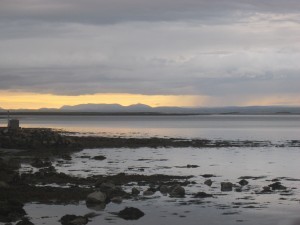
The Atlantic, photographed from Ballyvaughan at sunset
Ballyvaughan does not teem with attractions and visitors’ centres (it does, however, have a signpost that is a designated landmark. Really), nor does it have an ATM. We walked along the peaceful coast, admiring the flat ripples of the bay lapping against the stony strand. We passed a river bed which had grown thick with grass, and a small cluster of adorable donkeys nibbling where water once flowed. A sign on the pier advised us to be alert for signs of drug smuggling and provided a phone number to call if we saw any suspicious activity. I thought of Enid Blyton’s Famous Five books, of intrepid children in a rural idyll uncovering smugglers. For all its grittiness, the Customs Drugs Watch sign just served to underscore how much Ballyvaughan seemed to have landed here from another time.
We stopped for tea and an excellent chocolate cake in An Fear Gorta, took some photos in their gardens and walked back to the hotel. It was growing late, so we ate a meal of Atlantic seafood looking at the Atlantic, in a pub with walls covered in ephemera. It was pleasant and it was serene, but it may have seemed we came a long way for very little.
Not so.
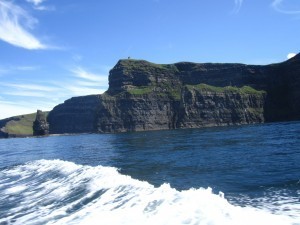
The Cliffs of Moher (or Insanity, if you prefer), seen from the sea below
Ballyvaughan is a short drive from the Cliffs of Moher, one of Ireland’s most famous landmarks. The Cliffs appeared in Harry Potter and the Half-Blood Prince, and had a major role in cult film The Princess Bride as the Cliffs of Insanity, which Fezzik climbed as Buttercup and Inigo clung to him. Our second day in Ballyvaughan was bright and still, so we headed for the Cliffs via the stunning coastal route. It is no longer possible to walk at the top of the Cliffs without paying an admission fee, and due to an unexpectedly strong objection to paying admission to be outdoors, we opted instead for a boat trip beneath the Cliffs, which was wonderful. As we waited to set sail, a dolphin swan under our small boat, and a column of rock rising from the water almost seemed alive as it teemed with sea birds. Admittedly we missed the views from the top, which are said to be stunning, but seeing the Cliffs from below did not feel like second-best.
Ballyvaughan also lies on the edge of the Burren, a unique and harshly beautiful limestone landscape. One of Oliver Cromwell’s generals (who, it must be said, may have been particularly blind to any charms the West of Ireland may have, since his boss told the Irish they could go to Hell or to Connaught) said that in the Burren, there wasn’t water enough to drown a man, wood enough to hang him nor soil enough to bury him. Nevertheless, a surprising amount of plant life thrives in the cracks between the limestone ‘pavement’. The Poulnabrone dolmen, a Bronze Age grave dating from 1750 BCE, is an iconic symbol of Ireland and worth the walk. The Burren is bleak, stony, grassy and still – but there is nothing like it anywhere else in Ireland.
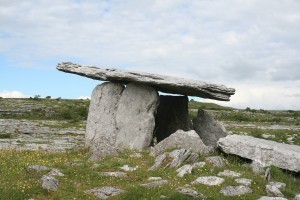
Poulnabrone dolmen, a grave dating from the Bronze Age.
On the edge of two iconic Irish landmarks and with a charm all of its own, Ballyvaughan was worth the drive. Be warned, though – we couldn’t find the fabled ATM in the nearby town of Lisdoonvarna, and had to live on debit cards and pocket change until we hit Ennis on the way home. There may be such a thing as being too idyllic.
The post Clare, Ireland: Beauty Spots and Bank Machines appeared first on We Said Go Travel.
October 21, 2013
Broome, Australia: The Solace of Travel
I still remember the feeling in my chest, in my heart. The feeling was a mixture of despair, fear and an absolute sinking into somewhere unknown. “Six months”, she said as she looked at me with a fixed gaze, watching for my reactions, “they can start a course of chemotherapy, but it is only to give us more time together.” My mum started to cry, but continued to watch me, more concerned about my own reaction than her own fear. From that point on the world changed. I had heard people warn of this cliché before, but I was completely unprepared for this new world with a schedule of hospital visits, midnight calls of pain, overwhelming waves of sheer emotion and the absolute fear of the changes that appeared daily.
It was my mum’s suggestion, “We can stay at home and be sad, or we can take a trip and build some new memories together.” For as long as I can remember my mum had taken me on trips to far away places. I grew up in Australia but was the mixture of an American father and an Indian mother, and had lived for several years on my own in Switzerland. My mum was also a citizen of the world having lived for portions of her life in India, Malaysia, Ireland and now Australia. We loved nothing more than to go on an adventure together. I had inherited from her the need to roam beyond the places I knew to more challenging grounds. At 60 years old, she also knew what I at 27 had not fully yet realised, that each moment was to truly be cherished and that a seemingly simple idea to travel could entirely change perspectives and provide an relieving solace.
We scanned through travel agency websites looking for something that would be within our budget but also within her physical capabilities. “I want to go somewhere where the sun shines”, she said, and it was then that her eyes lit up and she called out, “Broome! I always wanted to go to Broome.” So the decision was made and a few weeks later we set off on a small airplane to travel from Perth to the north of Western Australia and the coastal town of Broome. Our vision of Broome had come from local travel documentaries with long sunny beaches and Pearl farms and whilst Broome did provide all of those attractions, we were grateful for the simple experiences that Broome gave us.
On a day with open blue skies, we wandering through the local market set up on a field. When she could walk no more, I spread out my scarf on the grass and my mum fell asleep whilst I read beneath the shade of a giant Boab tree. I felt the heat from the ground radiate through me and heard the distant sounds of buskers and chatter at the markets. I watched her face as she slept, free of worry and pain, finally relaxed in this place away from the reality of home. By chance we found a new seafood restaurant that night and enjoyed the fresh prawns and fish from the region, grateful for the opportunity to share the delicious food together. We joined the groups of tourists and watched the sunset over Cable Beach in the evenings casting a beautiful light across the ocean.
On the advice of a friend we stayed in an apartment near the beach. It had a pebble lined outdoor bathroom and shower, perfectly suited to the balmy heat of the Broome nights. The novelty of the bathroom spoke to the child in each of us, and silliness erupted whilst dancing under the moonlight or shrieking as a unaware frog joined someone under the shower. One evening after a swim at the beach my mum erupted into song in the outdoor shower, suddenly re-enacting a cabaret act in her bathing suit. On this trip to the tropics we had managed to recapture a feeling of being carefree, enjoying the moment that found ourselves in.
Just before my mum passed away she said to me in reflection, “I know that the time will come when you will need to seek something for yourself. Don’t be afraid to venture in the world as it may well bring you the peace you need.” I have continued to carry her message along on all of my journeys and have never failed to be grateful for each moment that I experience in the world around me.
About the Author: Sarita Slater is an avid adventurer and budding travel writer. Sarita has spent the last year traveling some of the world’s most beautiful areas. Her favourite travel destinations so far have been Antarctica, Cuba and Nepal. This article was written about a town in her home state of Western Australia.

The post Broome, Australia: The Solace of Travel appeared first on We Said Go Travel.
India: Absolute Relatives
India: Absolute Relatives
After living in India for the past month and a half and Indonesia earlier, we’d gotten pretty much used to power cuts. But not like this one.
If it was any other day, the electricity would cut off every now and then, a few hours here, a few there. For that time, all you can do when the fan stops spinning is close your eyes and keep saying to yourself, “This is not hell. This is just a sauna.” Today wasn’t like those other days. Today was a scheduled all-day blackout, where there’s absolutely no power from about 9 a.m. to 6 p.m. or later. This is normal, our hosts explain. Happens at least once a month. Just another day in the village.
Since mid-June, Asia and I have been living the village life. Staying with a family near Pondicherry in South India, on the outskirts of a town called Auroville. We came down this way only planning to stay a month. But we met a young woman in an internet cafe who told us her family had a room available that they rent out. The deal was way too good to pass up. Especially since we’d get that authentic experience of living with a local family, including homemade meals and squat toilets. We knew off the bat it’d be nothing like living in a hostel or guesthouse, so goodbye A/C, goodbye bed, goodbye Wifi. And that was all good because who really needs those luxuries anyway? I mean, what’s the difference between a bed and the floor other than height? And a squat toilet’s nothing but a crappy carnival game, if you think about it.
But that power. Crazy how that was the biggest adjustment. Not like we have any electronics other than our laptops and a phone. But the cuts happen without warning. Even if you try to expect them when you least expect them, you’ll still be surprised. And surprised we are today, sitting here with the daughter in the middle of a scorching afternoon. No matter what I tell myself, I know this is no sauna.
But it got me thinking about power. And how the same word we use for electricity and energy also stands for dominance and control. This thirst for power goes back to the beginning of time, far as I know. It seems to be hardwired into our DNA. That being said, does our humanity become our own excuse? Or are we expected, in an ideal world, to surrender that hunger for power because we’re conscious of it? On this one episode of RadioLab, I remember hearing that back in the ‘60s, one in three people thought humanity would eventually get to a point where there’s no more wars. Nowadays, only one in 10 people feel that way. Most feel like we’ll never evolve beyond our compulsion for power and greed and so forth.
Hard to see it any other way when you read about a girl named Heaven who was killed by a stray bullet in a Chicago candy store. Or when, even here in Auroville — a town built on principles of seeking divinity and attaining higher consciousness — a French girl riding her bicycle can be attacked, raped and burned alive, which is what happened a few weeks ago. That power. At the root of all the world’s ills, this is what we find. Except this is a perverted sense of power that creates darkness, not light. Will we ever evolve?
It’s going on 7 p.m. now. The power’s still not on. We’re sitting in the main room with the family, drinking Chai tea. The father’s sitting alone out on the porch. We found out that last year, the family had a big fight. From what we were told, the father got drunk one night and was going back and forth with his son when things turned violent. He took a torch, burned his son’s arm. The son swung a stick across his father’s face, knocking out several teeth. They still live under one roof, but they don’t speak to each other.
The son told us his side, but I’m sure there’s more to the story. The father doesn’t speak English so we can’t really talk to him. More often than not, he’s there, but not really there. It’s close to eight when the sun disappears. The village gets swallowed by shadows. In the home, the daughter lights candles so we can see.
I go out to the porch to sit with the father. We’re sitting here now in silence, watching chickens mill about in the dirt. We don’t speak the same language, but I recognize the pain in his eyes. Something in him that maybe wants things to be different. Maybe he refuses to swallow his pride. Or maybe prior attempts to reconcile failed. I don’t know. I can’t ask. But this is the same expression I’ve seen on the faces of many men, and in my own reflection, this need to feel in control. This internal power struggle that manifests in the world around us and hurts those closest to us.
Will we ever evolve? Hard to see from where I’m sitting.
The post India: Absolute Relatives appeared first on We Said Go Travel.
We Said Go Travel
We Said Go Travel is a global community of over sixteen hundred writers with articles from every continent.
Stories are shared with photos and video from a perspective of the transformative power of travel. We Said Go Travel has hosted live and online events as well as travel writing contests around the world. ...more
- Lisa Niver's profile
- 57 followers


